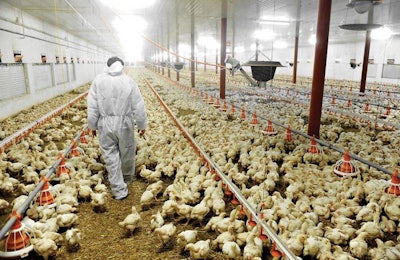
The goal of quantifying health status, in the context of nutrition, is to provide input data on which decisions regarding diet changes can be based. Of course this assumes that diet changes can be practically implemented in a timely manner upon the detection of a change in health status. If an acute health challenge occurs the day after a 3-ton feed tank is filled, any dietary changes will have to come in the form of water-soluble supplements and hand-feeding of pigs.
Counteracting the effects of an acute health challenge requires a rapid response specifically targeted to that particular disease.
Thus, many practical considerations related to feed manufacturing and delivery must be considered. It also is important to distinguish between “acute” and “chronic” health challenges. Acute health challenges lasting a short time are difficult to counter through dietary changes. On the other hand, chronic health challenges are those that tend to persist in production systems routinely for periods that may extend during the entire growing phase. Therefore, quantifying health status, in the context of what nutritional changes can be made to improve health status and growth, relates to the degree of chronic health challenge versus acute health challenge. Therapeutic strategies are more appropriate for acute challenges.
Acute-phase proteins
Acute-phase proteins, produced in the liver in response to infection and cytokine activity, are well-characterized but are also influenced by factors other than health status. Williams et al. (1997) fed pigs (6 to 112 kg body weight) of different health statuses five different protein levels. As expected, poor health status greatly increased circulating concentrations of the acute-phase protein, alpha-1 acid glycoprotein (AGP). However, dietary protein deficiency also created a markedly altered AGP level independent of health status. Pig age also affected AGP level. Therefore, if a baseline for AGP is established in a given herd, an elevated AGP level might be interpreted as a health challenge when it is actually elevated due to inadequate dietary protein. The dietary changes appropriate for inadequate protein versus severe health challenge are not likely the same. A plethora of other acute phase proteins exist which can be assayed and are sensitive indicators of infection.
Antibody titers
Antibodies produced in response to pathogenic organisms are relatively easy to quantify in swine serum. This allows diagnosis of specific pathogens to which pigs have responded immunologically. Researchers at Iowa State University used a combination of immunological titers and the concentration of AGP to characterize the health status of two groups of pigs reared via different management schemes. Pigs reared via segregated early weaning schemes had no antibody titers to common pathogens in the herd of origin, low AGP levels and a high rate and efficiency of gain. Pigs reared in a continuous flow environment possessed antibody titers to pathogens in the herd of origin, had higher AGP levels and a lower rate and efficiency of gain. In this study, the presence of antibody titers did seem related to immunological stimulation expressed as AGP levels.
Acute health challenge
Counteracting the effects of an acute health challenge requires a rapid response specifically targeted to that particular disease. Typically these responses come in the form of:
- Injectable antibiotics
- Water-soluble antibiotics and therapeutics
- Pre-determined nutritional strategies based on anticipated health challenge
These approaches allow either a rapid response or an altered set of dietary nutrients provided continuously. If the relative risk of disease outbreak is low, relying on rapid responses may be the best solution because there is always a cost of altering the diet. Increasing levels of certain nutrients is expensive if an anticipated disease does not occur. Likewise, decreasing dietary amino acid density is biologically inefficient if a disease does not take hold. But in production systems where disease load is continual, or the risk of disease is high, nutritional intervention may be appropriate.
Chronic health challenge
The prevailing theory on amino acid nutrition for carcass protein deposition during a health challenge states that because protein accretion rate is decreased, amino acid requirements for growth are decreased. For example, chicks subjected to immunologic stress had lower lysine and methionine needs for growth compared with healthy chicks. Also, chicks fed a methionine deficient diet did not exhibit increased levels of pro-inflammatory cytokines in response to immunologic stress. In addition, pigs reared via management schemes that resulted in a high level of immune system activation had slower and less efficient body growth, a lower percentage of carcass muscle and required lower levels of dietary amino acids to maximize growth. The degree to which amino acid requirements are lowered will depend on severity of the health challenge.
In brief
Matching nutritional inputs to a disease challenge can have several benefits, even though nutrition cannot generally overcome all the effects of disease.















